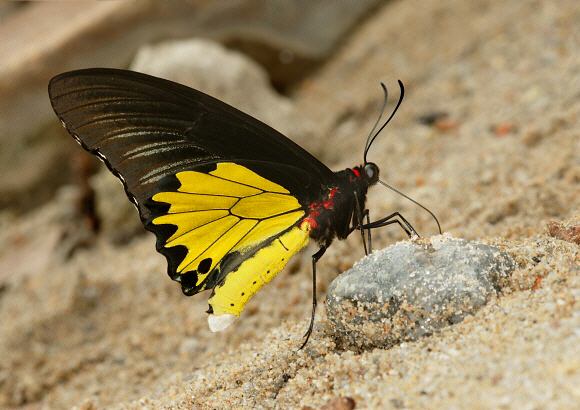
Introduction
There are 21 Troides species although Trogonoptera ( 2 species ) and Ornithoptera ( 13 species ) are also included in Troides by some workers. The true Troides Birdwings are all similar to helena, with black elongated forewings and extensive areas of metallic golden yellow on the hindwings. The yellow areas are iridescent, and at extreme angles can reflect green violet, orange or purple hues.
Troides helena is the commonest and most widespread member of the genus, being found in India, Myanmar, Thailand, Vietnam, south China, Taiwan, West Malaysia, Singapore, Sumatra, Sarawak, Brunei, Sabah, Kalimantan, Sulawesi, Java and Bali.
Habitats
This species is found in primary and secondary rainforest at elevations between sea level and about 800 metres.
Lifecycle
All Troides species use Aristolochiaceae as their larval foodplants. T. helena has been recorded on Aristolochia indica, A. tagala, and Bragantia wallichi.
The eggs are large, spherical, pink in colour, but coated in an orange glutinous substance. They are laid singly on the upper surface of leaves of the foodplants, on the midrib, near the tip.
The caterpillar, which is toxic to birds, when fully grown is dull brown, with a broad white diagonal bar along the side of the middle section. It has several rows of long recurved fleshy protuberances along the back and sides.
The chrysalis resembles a dead leaf. It is pale olive-brown colour, marked with fine striations, and has a dull yellowish saddle mark on the back. The abdomen is curved into an S shape, and has a double row of dorsal thorns. It is attached vertically to a stem, or sometimes suspended beneath a leaf, attached by the cremaster and a strong silken girdle.
Adult behaviour
In the morning the females sit on foliage high in the trees, while males glide in broad circles above them trying to locate potential mates. Upon discovering a female the male performs an elaborate quivering courtship dance several metres above her, before alighting beside her to copulate.
Later in the day both sexes can be seen fluttering around flowering trees and bushes including Lantana. When nectaring they usually keep the wings constantly fluttering.
